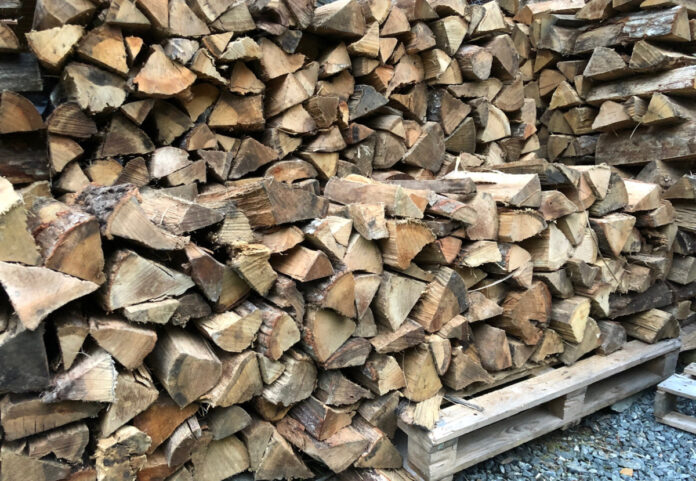I love to watch YouTube videos, especially vlogs and how-to videos related to homesteading, bee keeping, wood working, firewood, off-grid living, and prepping. Whenever I need to know how to do something, I’ll watch a few how-to videos. In fact, I joking call it “Going to YouTube University.”
But YouTube can be misleading. Sometimes the “talent” does not know what they are doing, sometimes they only show you the pretty parts. Worse yet, the speed through the actual hard, boring work.
For example, we just had our fifth cord of wood delivered for this year’s heating season. They spill it out of the dump trailer and it forms a wide pile of wood about 15 feet long and two feet high. I heat my house with a large wood stove, so I get large, heavy splits of wood designed to burn for hours rather than smaller campfire pieces.
Stacking the firewood is a hassle. I have to bend down, pick up two or three pieces and place them on the pallets in a neat, orderly row. (When I carry them inside during the winter I load up five to seven pieces in my arms, but when stacking them, I often grab one in each hand, especially if I am in short sleeves). At first, the stacking goes quickly because the pile of wood and the pallet are close to each other and at the same height. I can grab two logs, turn and stack two longs. Later, the pile gets higher and I’m lifting the wood and staking it carefully to keep the pile from leaning and tipping over. In fifteen minutes, I’m having to walk back and forth to get the wood from the middle of the stack and I’m stacking it above my shoulders.
On YouTube, the firewood folks usually speed through the actual stacking, getting it done in 20 seconds. I can’t blame them, I don’t want to watch a guy stack firewood for 20 minutes. But don’t for a minute think stacking firewood is easy.
Curation is Critical
Sometimes, YouTubers do stupid stuff for entertainment purposes but sometimes through ignorance. They can also give you inaccurate or outdated information. Sometimes they show you what works for them, but your situation is different, so it won’t work for you. Sometimes their equipment differs from yours, so the concept is fine, but the specifics are lacking. You must use your best judgment and don’t accept the first video you see as the ideal solution.
Let’s say that I want to wire up a room with one light fixture in the ceiling and three different switches, all of which must be able to turn the light on and off. I have basic wiring skills, but it’s been years since I pulled any cable, so I go to YouTube University. What I have learned is that I need to watch four or five YouTube videos from different sources and evaluate the information they contain.
Only when several videos tha concur on the best approach am I comfortable using it. Then I pick the video where the wiring plan is consistent with the others, but the scenario is closest to my room, and the YouTuber gave the best explanation. At this point, I don’t care if the presenter is a veteran electrician or a 24-year-old who has little or no electrical experience. I just want easy-to-understand step-by-step instructions.
When you find a good video, give it a thumbs up and then it will be saved in your history under likes. This is helpful if you need to review it again. If you find they have more pertinent content, then subscribe to their channel.
Sometimes, There is No Right Answer
Raising backyard chickens is a popular subject for YouTube videos. I’ve gotten some good ideas on automatic feeders and automatic chicken doors from YouTube. But what I have also observed is that there are dozens of different ways to raise chickens, and just because one works for one YouTuber doesn’t mean that the other ways are wrong.
In this case, I will watch multiple videos and I will pick tidbits from each one to adopt for myself. When I built my chicken coop and my raised beds for the garden, I took the best ideas I saw and incorporated them into my plan.
Here’s one thing I adopted: A YouTuber grabs up handfuls of weeds and grass growing near his chicken run and tosses it inside for the birds. I started doing this and my chickens love it. Best of all, it’s pretty simple to do. Any time I am outside heading that direction, I grab a couple of handfuls of greenery (avoiding my wife’s garden, of course) and toss over the fence for the chickens.
Another example is that some people choose to let their broody hens sit, hatch, and raise their own chicks. Others harvest the eggs and stick them in an incubator. Guess what, both methods can work. Use whatever approach is most suited for your coop, your breed of chickens, and your equipment.
In other words, don’t just curate, but keep an open mind. You are watching to learn, not copy. Feel free to adapt and improvise.
20-Minute Projects–Ha!
I can’t tell you how many videos I’ve watched where the cute couple or the funny fellow finish a project in 20 minutes. Of course, they start with pre-cut lumber, they don’t have to keep walking back into the workshop to get another tool, they don’t have to stop because of inclement weather, and thanks to the magic of editing, if they make a mistake, you will never know.
It’s wildly misleading. In some cases, they built the project once already and worked out all the kinks. In most cases, they do all the prep-work and staged and the parts and equipment they needed before the cameras were rolling. Of course, it looks simple and they look successful. If I could yell “Aaand cut” like Jim Gaffigan and start projects over, I would. Instead, I get to swear, pull out that nail, and tell myself no one will notice that hole when I’m done.
Hiding Errors
I like it when YouTubers make errors and laugh about it. We all do it.
I built a huge garden gate recently, assembled it just outside my shop and carried it to the garden. The good news is that I had measured correctly and it fit between the fence posts. The bad news was that I had mounted the hinges on the wrong side of the gate. Unfortunately, the worse news was that I didn’t realize the problem until I leveled and mounted the gate to the post. It opened, but it didn’t swing very wide because the hinge was backwards.
My saving grace was that I had used nuts and bolts to affix the hinge through the gate. I was able to unbolt them and reattach them on the other side using the same holes. Still, I had to run back to the shop, get the socket set, the open ended wrench, and a couple other tools. Then I had to have my wife hold the gate upright while I did the work. I’m sure you can imagine how excited she was about it.
The gate works fine, and I’ll never make that mistake again. But if I was on YouTube, you would never know.







